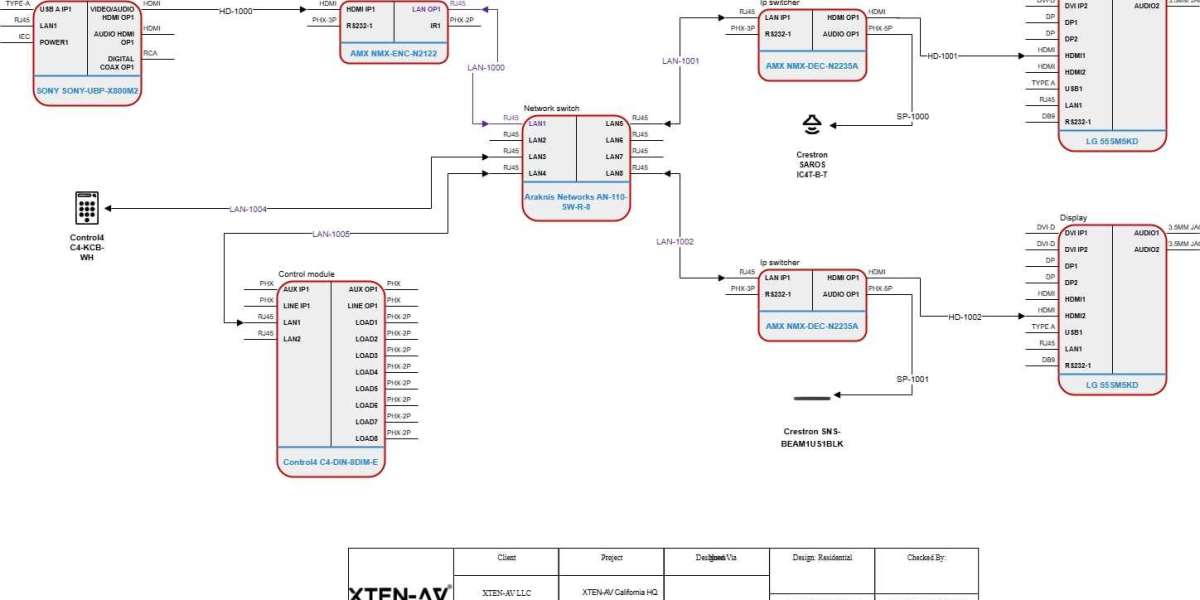Schematic Drawing Software is essential for visualizing complex systems, from AV installations to smart home setups and data center infrastructure. Traditionally, designers manually created diagrams, checked connections, and verified layouts, which could be time consuming and prone to human error. AI powered schematic tools automate many of these tasks, providing intelligent suggestions, error detection, and design optimization.
With AI integration, schematic software not only speeds up diagram creation but also helps ensure accuracy, maintain compliance, and facilitate collaboration. Comparing AI powered features across different tools helps businesses choose the software that best fits their workflows and project requirements.
Key AI-Powered Features in Schematic Software
1. Automated Component Placement
AI powered schematic tools analyze your design and suggest optimal placement of components based on signal flow, space constraints, and functional grouping. XTEN-AV, for example, automatically organizes devices in AV and low voltage system schematics, reducing manual layout time and improving readability.
2. Smart Routing and Connectivity
AI algorithms can determine the most efficient paths for connections, minimizing wire lengths, avoiding interference, and ensuring logical signal flow. This reduces errors and improves system performance.
3. Error Detection and Validation
AI powered schematic software identifies potential issues such as miswiring, voltage mismatches, and incompatible components. Real time validation alerts users to errors before installation, saving time and preventing costly mistakes.
4. Design Recommendations
AI can provide recommendations for optimizing layouts, component selection, and system design. For example, it may suggest alternate components based on availability, cost, or performance, or optimize rack layouts for airflow and accessibility.
5. Automated Documentation
AI assists in generating detailed reports, bills of materials, and installation guides directly from the schematic. This ensures consistency, accuracy, and reduces the effort required to produce professional documentation.
6. Predictive Project Management
Some AI powered tools integrate project management by predicting timelines, resource requirements, and potential bottlenecks based on the schematic. This allows teams to plan effectively and meet deadlines.
Comparing Popular AI-Powered Schematic Tools
D-Tools AI Features
D-Tools focuses on AV and low voltage system design and includes some AI powered features:
Component Libraries – Prebuilt AV components with intelligent placement suggestions
Error Checking – Alerts for miswiring and layout issues
Integration with Project Management – Predictive project insights based on system complexity
Pros:
AV focused with intelligent design features
Integrated with documentation and project management
Reduces manual errors in complex designs
Cons:
AI capabilities may be limited to specific AV workflows
Learning curve for advanced AI functions
Visio AI Features
Microsoft Visio leverages AI through Microsoft 365 integrations and design suggestions:
Shape Suggestions – AI recommends shapes and layouts for diagrams
Connection Assistance – Suggests logical linkages between elements
Collaboration Insights – Highlights areas where team input is needed
Pros:
Familiar interface for Microsoft users
Useful for general diagramming across industries
AI assists with layout and productivity
Cons:
Not specialized for AV or electronics schematics
Limited AI support for component validation or system optimization
XTEN-AV AI Features
XTEN-AV provides a comprehensive set of AI powered features tailored for AV, IoT, and low voltage systems:
Automated Component Placement – Optimizes rack and system layouts automatically
Smart Routing and Connectivity – Suggests efficient paths for cables and signal lines
Real Time Error Detection – Identifies wiring errors, incompatibilities, and voltage mismatches
Design Optimization Suggestions – Recommends components and layouts based on performance and cost
Automated Documentation – Generates BOMs, reports, and guides instantly
Predictive Project Management – Estimates timelines and resource requirements from schematic data
XTEN-AV’s AI features make schematic creation faster, more accurate, and highly collaborative, ensuring projects are completed efficiently and professionally.
Advantages of AI-Powered Schematic Software
Increased Efficiency – AI automates repetitive tasks, reducing design time significantly.
Improved Accuracy – Automated validation and error detection minimize mistakes.
Optimized Designs – AI suggestions improve component placement, wiring paths, and overall system layout.
Enhanced Collaboration – Cloud integration and predictive insights allow teams to work together effectively.
Professional Documentation – Automated reports and BOMs reduce manual work and improve consistency.
Best Practices for Using AI in Schematic Software
Leverage Automated Suggestions – Use AI recommendations for placement, routing, and component selection.
Validate Designs Regularly – Trust AI validation but review diagrams manually for critical systems.
Integrate with Project Management – Link AI insights to timelines and resource planning.
Collaborate in Real Time – Ensure team members provide feedback and updates directly in the software.
Keep Libraries Updated – Regularly update component libraries to maximize AI accuracy and efficiency.
Conclusion
AI powered features in Schematic Drawing Software are transforming how designers, engineers, and AV integrators work in 2025. Automated component placement, smart routing, error detection, design optimization, and predictive project management improve efficiency, accuracy, and collaboration across projects.
XTEN-AV stands out as a leading AI powered solution. Its comprehensive set of intelligent features, cloud collaboration, and integration with project management makes it ideal for AV, IoT, and low voltage system designers. Leveraging XTEN-AV ensures that schematic creation is faster, more accurate, and professional, giving teams the tools they need to succeed in complex and demanding projects.
Read more: https://myliveroom.com/blogs/20147/Comparing-Performance-Free-vs-Premium-Schematic-Drawing-Tools








